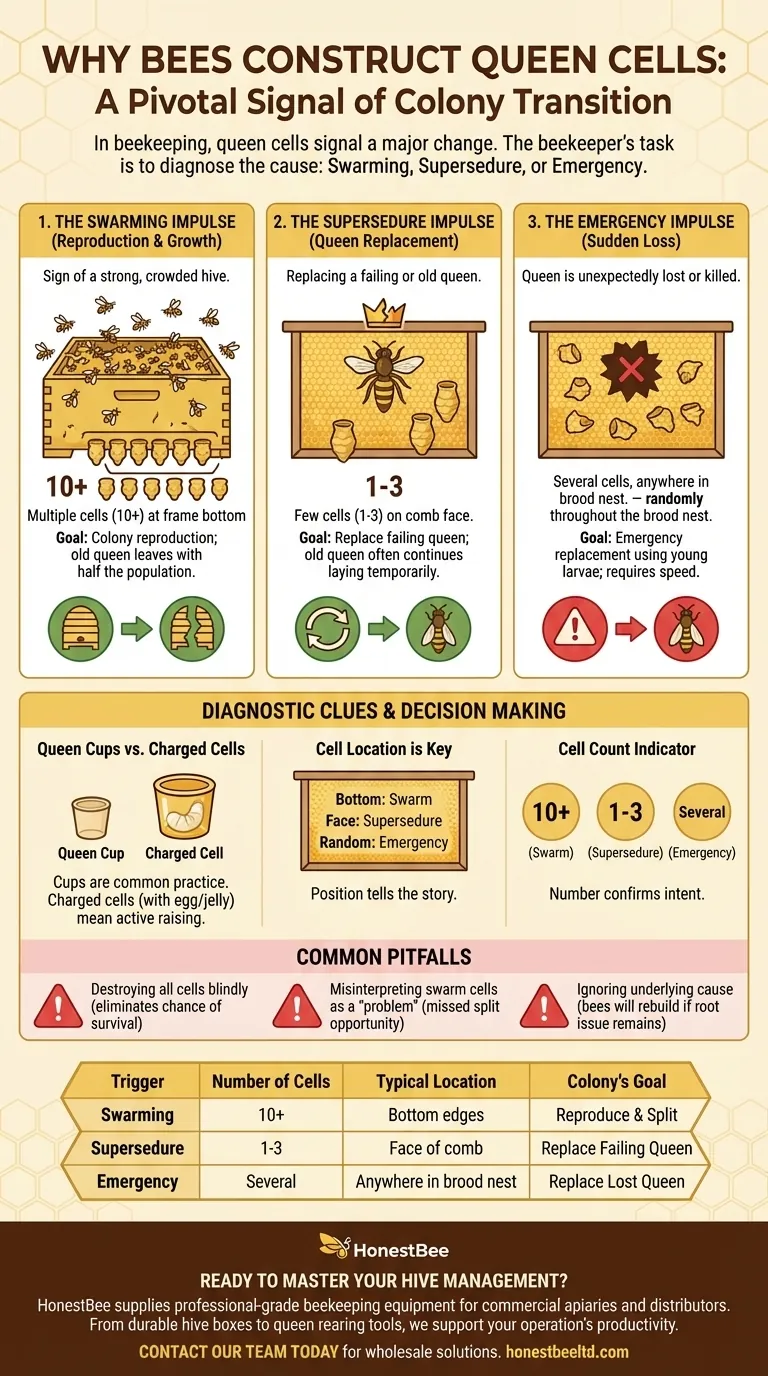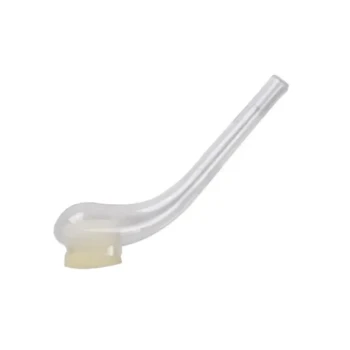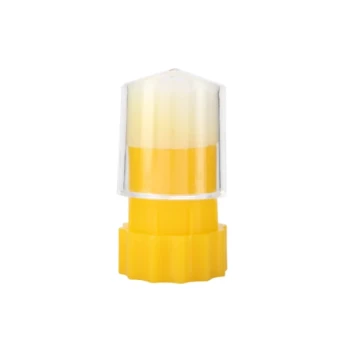In beekeeping, the construction of queen cells is a pivotal signal that the colony is undergoing a major transition. There are three primary reasons for this activity: the colony is preparing to swarm, it is replacing a failing or old queen in a process called supersedure, or it is raising an emergency queen because the original has been unexpectedly lost or killed.
Finding queen cells is not necessarily a sign of a problem, but a signal of the colony's natural lifecycle. The beekeeper's task is to interpret why the cells were built—be it for swarming, supersedure, or emergency—as the colony's future and the beekeeper's required response depend entirely on this diagnosis.

The Three Triggers for Queen Cell Construction
Understanding the "why" behind queen cells requires looking at the colony's overall condition. Each trigger leaves distinct clues for the observant beekeeper.
The Swarming Impulse
Swarming is the natural method of reproduction for a honey bee colony. It is a sign of a strong, healthy, and often crowded hive.
When a colony decides to swarm, the bees will build multiple queen cells, often ten or more. These cells are typically located along the bottom edges of the frames. This proactive measure ensures a new queen is ready to take over after the old queen leaves with about half the hive's population.
The Supersedure Impulse
Supersedure is the colony's process for replacing a queen who is no longer performing adequately. This could be due to old age, injury, or poor egg-laying.
Unlike swarming, supersedure is a more controlled event. The bees will create a very small number of queen cells, typically just one to three. These cells are usually found on the face of the comb, not clustered at the bottom. The old queen is often allowed to continue laying eggs until the new virgin queen has successfully mated and returned.
The Emergency Impulse
An emergency situation arises when the queen is suddenly and unexpectedly lost. This could happen if she is accidentally crushed during an inspection, eaten by a predator, or fails to return from a mating flight.
In this desperate scenario, the workers must act fast. They will select several existing female larvae—those less than three days old—and begin converting their standard worker cells into queen cells. These emergency cells can appear anywhere in the brood nest where young larvae were present and often look haphazardly constructed.
Key Diagnostic Clues for the Beekeeper
To correctly identify the colony's intent, you must act like a detective, using the location, number, and type of cells as your evidence.
Queen Cups vs. Charged Cells
Bees often build empty "practice" queen cells called queen cups. These are small, downward-facing cups that look like the base of a queen cell. They are common and do not, by themselves, indicate a problem.
A cup becomes a charged queen cell only when the queen lays an egg in it and the workers begin feeding the larva a diet of royal jelly. A charged cell is a definitive sign that the colony is actively raising a new queen.
Cell Location Tells the Story
The placement of the cells is one of your most reliable indicators.
- Bottom of the frame: A strong sign of swarm preparation.
- Face of the comb: A classic sign of supersedure.
- Anywhere in the brood nest (from modified worker cells): A clear signal of an emergency queen replacement.
Cell Count is a Critical Indicator
The number of queen cells provides further confirmation. A large number of cells (10-20+) almost always points to swarming, as the bees are creating backups to ensure success. A very small number (1-3) points to the more controlled process of supersedure.
Common Pitfalls in Managing Queen Cells
A beekeeper's intervention can either save or doom a colony, depending on whether their actions are informed by a correct diagnosis.
Destroying All Queen Cells Blindly
The most common mistake is to panic and destroy every queen cell you find. If the colony is in the process of supersedure or emergency replacement, you have just eliminated its only chance to raise a new queen and ensure its survival.
Misinterpreting Swarm Cells as a "Problem"
Swarm cells are not a sign of a sick hive; they are a sign of a successful one that has outgrown its space. Seeing them as a problem to be "fixed" by simply cutting them out is a missed opportunity. This is the hive giving you a clear signal to manage its growth, often by making a split.
Ignoring the Underlying Cause
Simply removing queen cells without addressing the root cause—such as overcrowding for a swarm or a failing queen for supersedure—is ineffective. The bees will almost always rebuild the cells because the underlying impulse has not been resolved.
Making the Right Choice for Your Colony
Your response should be dictated by the evidence you gather during your hive inspection.
- If your primary focus is preventing a swarm: Seeing many cells on the bottom of frames means you should act quickly to relieve congestion, such as by making a split or adding more space (supers).
- If your primary focus is colony health: Seeing a few cells on the face of the comb means you should generally step back and allow the bees to replace their failing queen, as they are improving their own stock.
- If your primary focus is saving a queenless hive: Seeing emergency cells means you must protect them at all costs and avoid disturbing the hive until a new queen has successfully emerged and mated.
Understanding these signals transforms you from a reactive keeper into a proactive partner with your colony.
Summary Table:
| Trigger | Number of Cells | Typical Location | Colony's Goal |
|---|---|---|---|
| Swarming | 10+ | Bottom edges of frames | Reproduce and split the colony |
| Supersedure | 1-3 | Face of the comb | Replace a failing/old queen |
| Emergency | Several, anywhere | Throughout brood nest | Replace a suddenly lost queen |
Ready to Master Your Hive Management?
Understanding queen cells is just the beginning. As a commercial beekeeper or distributor, having the right equipment is crucial for responding effectively to your colony's needs—whether you're making splits to manage swarming or providing optimal conditions for a new queen.
HONESTBEE supplies professional-grade beekeeping supplies and equipment designed for the demands of commercial apiaries and distributors. From durable hive boxes and frames to essential tools for queen rearing and swarm control, our wholesale-focused operations ensure you get reliable, high-quality gear that supports your colony's health and your operation's productivity.
Let's strengthen your beekeeping operation together. Contact our team today to discuss your specific equipment needs and how we can support your success.
Visual Guide

Related Products
- Brown Nicot Queen Cell Cups for Breeding Queen Bees Beekeeping
- JZBZ Push-In Queen Cell Cups for Beekeeping
- JZBZ Type Wide Base Plastic Queen Cell Cups for Base Mounting and Queen Rearing
- Clear Black Plain Polystyrene Queen Bee Grafting Cell Cups No Lug for Bee Queen Cup
- JZBZ Langstroth Queen Rearing Frame for Beekeeping
People Also Ask
- Why is it important to select a healthy larva less than 24 hours old for queen rearing? Maximize Queen Quality and Colony Strength
- What should be done with extra queens from grafting? A Strategic Guide for Apiary Management
- What is the benefit of inducing supersedure by giving a queenright colony a protected queen cell? A Seamless Requeening Method
- How are the queen cells raised after removing the plugs? Master the Art of Queen Rearing
- How many cells are given to a nucleus? Understand the One-to-One Rule in Cell Biology


















